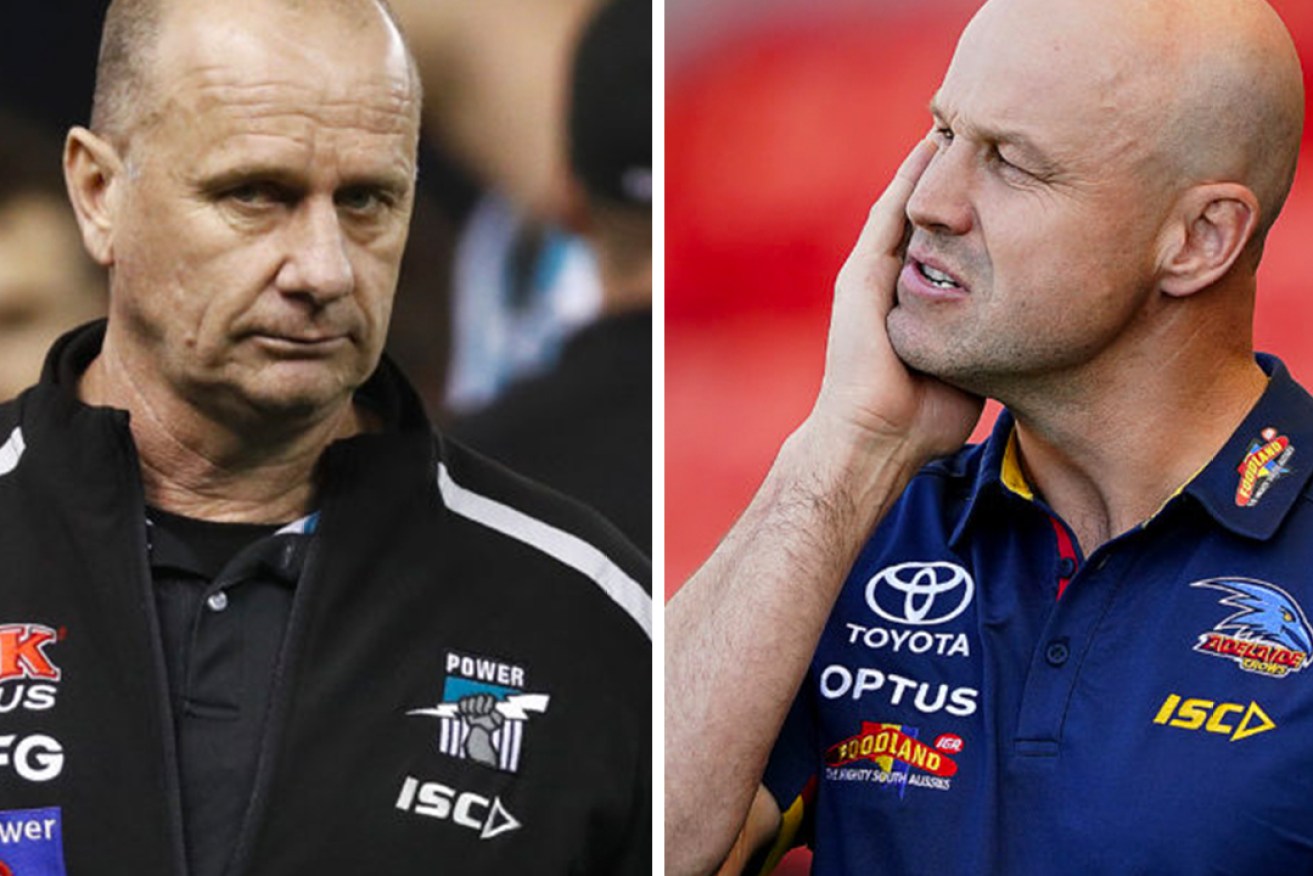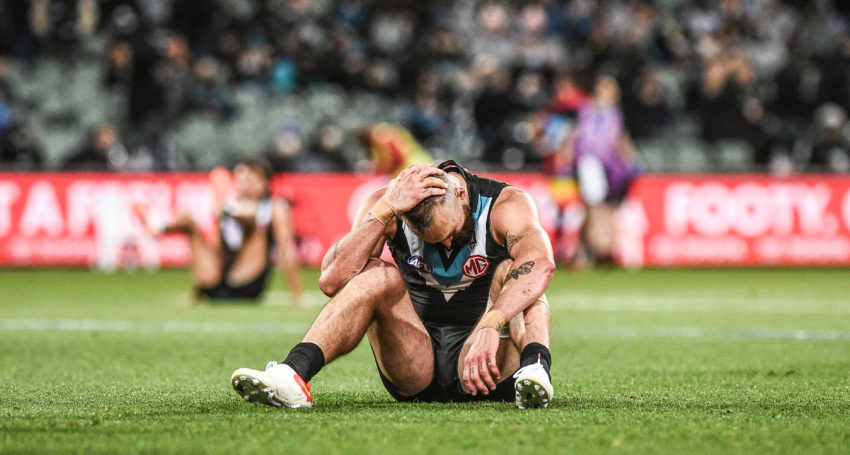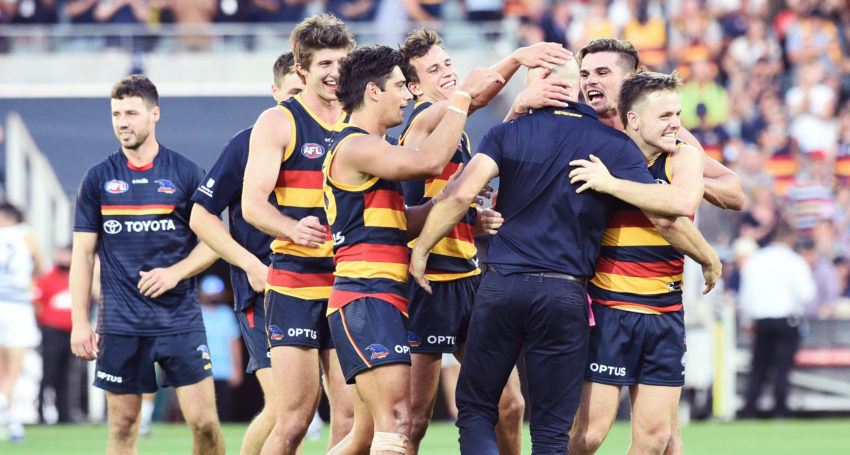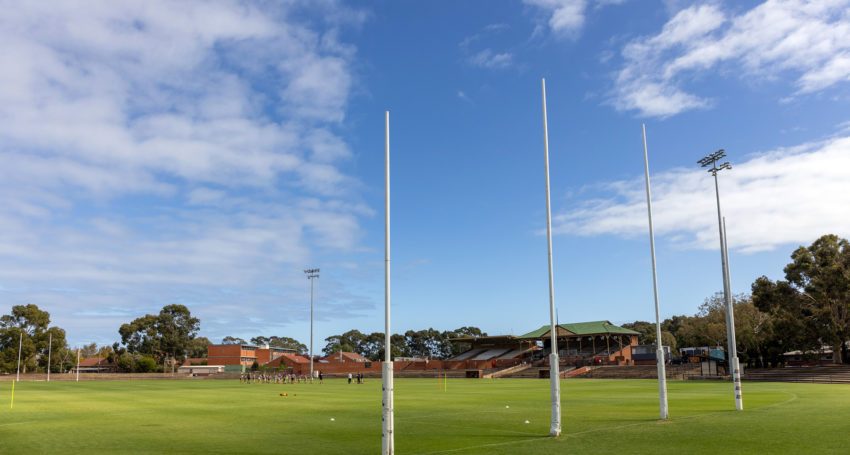Testing times as Port and Crows struggle to keep the faith
AFL football returns this week and for Crows and Port Adelaide fans it will be a season that tests their faith – and their patience. Michelangelo Rucci reports.

Port Adelaide coach Ken Hinkley (left). Photo: AAP/Daniel Pockett. Crows coach Matthew Nicks, right. Photo: AAP/Dave Hunt. Composite image: InDaily
“Believe.” On the back of buses criss-crossing the city, the slogan asks Adelaide Football Club fans to hold faith. In radio commercials, Crows coach Matthew Nicks virtually pleads for patience: “And (you) will get the rewards when we get back up and fight for the premiership again.”
When? There is no quick fix at Adelaide, which claimed the wooden spoon in 2020 and is taking a measured approach to its rebuild as a premiership contender.
The same emotional string is being pulled by rival Port Adelaide, which was on its knees a decade ago with its AFL licence at risk. But at Alberton the fans are tired of waiting for a return to the MCG on Grand Final day. That dream has remained unfulfilled for 14 years; it took only seven years after entry to the national league in 1997 for Port Adelaide to win a premiership.
Ken Hinkley, starting his 10th season as senior coach, is forced to publicly sell the club ambition of winning the 2022 AFL flag and at least another two by 2025

Photo: Michael Errey/InDaily
“We set out in 2022 to win the premiership,” Hinkley says, as his bosses at Alberton demand his team lives to high aspirations while the club promotes the mantra of existing to win premierships. “Everyone in this game is driven by ultimate success – and that is what drives me and this club that believes in premierships.”
It’s now 17 years since they poured champagne into a premiership trophy at Port Adelaide; the longest drought in the club’s history that dates to 1870. And this lack of on-field success that once seemed to be taken for granted at Alberton has worn down many Port Adelaide fans.
Hinkley, once a saviour, is now mocked for his bold statements in the same way the boy who cried wolf lost all credibility. More and more supporters, scarred by bitter exits from consecutive home preliminary finals during the past two seasons, no longer believe. And they certainly have run out of patience. It is now or …

Port Adelaide after the 2021 second preliminary final loss against the Western Bulldogs at Adelaide Oval. Photo: Michael Errey/InDaily
Welcome to AFL football, South Australian style, in 2022. This is the year of the local fans being tested in their faith, and their patience. Do they believe? At least, after two years of demanding COVID protocols, they can once again take their seat at Adelaide Oval without enduring a ballot to claim a ticket to a restricted venue. And they can travel interstate for matches at the MCG, SCG, Gabba and most probably Perth.
Crows fans will return to a full capacity Adelaide Oval (53,500 tickets) on Sunday to play a recharged Fremantle, with probably more interest in the shape of their new-look team than the composition of a new parliament decided by the state election the previous day.
Port Adelaide supporters on Saturday night at the Gabba will get an indication of how their team measures against early flag favourite the Lions. Hall of Fame coach Michael Malthouse already has made his call: Port Adelaide, after top-four finishes in the past two seasons, including the minor premiership in 2020, will fall to the also-rans in the AFL bottom 10.
“It would have been easy for me to leave Port Adelaide in the eight,” Malthouse said. “But when you’ve got a side that should be winning the games that get them into the grand final, they’re not doing it.
“Sides will come up underneath them and take that role, this is where Port Adelaide has got to come to grips that some of their players have to perform better on the big stage,” adds Malthouse who is critical of the speed in the Port Adelaide defence and the team’s under-performing forwards and reliance on key forward Charlie Dixon.
Both the Crows and Port Adelaide will start as underdogs in round one of the six-month home-and-away competition that the AFL says will continue regardless of varying COVID protocols that could have teams raiding the SANFL for emergency “top-up” players.
For Nicks, who has a 10-29 win-loss record in his two seasons at Adelaide, another loss will do no damage to his long-term prospects. Originally out of contract at the end of this season, his deal was extended during the summer to the end of 2024; a brave move by the Adelaide board considering similar extensions for senior coaches Brenton Sanderson and Don Pyke led to early exits and hefty payouts.
Adelaide chairman John Olsen, who admires Nicks for building a new culture among the playing group, wants his coach to concentrate on now developing footballers and a successful game plan rather than be distracted by an expiring contract.
Hinkley, who has an above-average 60 per cent winning record in home-and-away football with a 116-76 win-loss count, technically should coach Port Adelaide next year when his much-debated contact expires. But the general impression is Port Adelaide president David Koch will be introducing a new coach in October if Hinkley fails to deliver at least a Grand Final appearance this year.
This new coach – with Alastair Clarkson and Nathan Buckley and even 2004 Port Adelaide premiership coach Mark Williams to factor in the temptations at Alberton – would have to win three premierships in a row to meet the ambitions of the club’s “Chasing Greatness” manifesto.
Olsen speaks of “patience”, a rare luxury afforded to coaches and club boards in a league that rewards just one of 18 teams each year. Adelaide says it “exists to play finals”. The Crows have not played a top-eight final since their damaging 2017 AFL grand final loss to Richmond at the MCG. This is expected to be fifth year of a barren September. The previous longest dry run was three seasons during the club’s pioneer days, 1994-1996, that was followed by the double premiership success that confirmed coach Malcolm Blight as “the messiah”.
Nicks today manages an incredibly raw list. His football boss Adam Kelly has all the numbers to emphasise just how underdone the Crows squad has become in one of the hardest “bottoming out” exercises in AFL list management. “We are 39 games into the rebuild,” says Kelly. “From the third-oldest squad in the AFL in 2019, today we have the youngest – for the second season in a row.”
Adelaide won seven of 22 games last season. Only the highly talented Greater Western Sydney has done better – 11 wins in 2015 – with the league’s youngest squad.

The Crows celebrate after beating Geelong last March. Photo: Michael Errey/InDaily
Like Olsen, Kelly preaches “patience” – and he insists the much-criticised list management team at Adelaide will not make knee-jerk reactions should on-field results create doubts among the pundits and fans. The commitment to this player group – and the “buy in” from the players – is highlighted by 31 players being on contract beyond this season, a stark contrast to the image of a club repeatedly criticised during the past decade for failing to hold talent.
“We will not change strategy,” says Kelly of a plan to continue to seek early draft picks and now start adding selective “mature” players from rival clubs, as the Crows did with South Australian Jordan Dawson from Sydney in last year’s AFL trade period.
Nicks reveals the club’s leaders commissioned much more than a forensic review of Adelaide’s list management that concluded list manager Justin Reid and recruiting manager Hamish Ogilvie had just one bad draft-trade period across a five-year span.
Nicks explained the Crows looked at every recent rebuild in the AFL, and settled on picking up the template of one successful rival. He will not name that club. Nicks is almost as vague on how he wants his team to play. He refers to game style as a team’s “DNA”. He wants his players to be “in the face” of opponents and making them “know they have played the Crows”. He wants to finish games with Adelaide members offering standing ovations from the terraces.
“If we put up a performance that our fans are proud of, they will let us know,” Nicks says. “They will say ‘THAT is us’ … and if it is not good enough to get the job done it is because we were not good enough on the day.”
Club champion Rory Laird, who will miss the first six weeks of the season with a broken hand suffered in the pre-season closer against Port Adelaide at Richmond Oval on Saturday, reinforces the Nicks game plan is very much built on effort rather than style.
“It’s not exactly about all the ‘sexy’ stuff,” Laird said. “It is about putting in an effort. You saw last year when we brought the fight in a lot of games, and won (most notably against long-standing measuring stick Geelong in round one and eventual premier Melbourne). Our young guys need more experience. And we will play a brand that does make our supporters proud and happy in the way we go about it.”
Nicks, a 175-game player with Sydney, is the atypical modern AFL coach who believes the game is built on a strong foundations of defence. Adelaide is a long way from the 2017 grand final team that averaged 108 points a game and broke the watershed 100-point barrier 15 times in 25 matches with an attack that thrived with Taylor Walker, Eddie Betts, Josh Jenkins and Tom Lynch. Under Nicks, the Crows last season – with only Walker still in the line-up – averaged 73 points and cracked the ton just three times in 22 games.
It is telling that 18-year-old Josh Rachelle, the 180-centimetre “small” forward picked at No. 6 in the recent AFL national draft, is considered (before he has made his AFL debut) the best bet to be Adelaide’s leading goalkicker this season.
Under Hinkley, Port Adelaide since 2013 is second only to Geelong for wins in home-and-away football (133 victories to 116). There is no doubt Hinkley has developed players to their fullest, as noted with midfielder Ollie Wines’ success in the Brownlow Medal count last year.
But Port Adelaide fans want a premiership team.
“I love the way Ken Hinkley coaches, I’ve got a great of admiration for him,” says Malthouse. “But when the chips are down and Port Adelaide plays the big sides in the big games that count the most on the big stage, too many of his big-name players go missing.”
If Hinkley cannot change this script this season, the well-known outcome – change the coach, not the players – will inevitably unfold at Alberton.
Off field, Adelaide is having its patience with its search for a new home tested. The clock is ticking on the $15 million grant offered by the federal government in May 2019. The expiry date on these funds is June 30. Adelaide already has tested the patience of Canberra with two requests for extensions.
The Crows could have their bid for the old gasworks at Brompton revived next week if Labor is elected, with the party promising to review the process which awarded the site to a Melbourne developer. The Adelaide Football Club is the second preferred bidder.
The alternative, Thebarton Oval, is a complicated deal regardless of the City of West Torrens seeking to engineer a simple swap of leases between the West Lakes-based Crows and the SANFL that intends to build its headquarters at Thebarton.
InDaily has learned the SANFL cannot walk away from Thebarton Oval without first offering to return the lease to original holder the Adelaide Footy League, the community-based amateur competition also based at Thebarton.
When the Adelaide Footy League negotiated with the SANFL – led by Olsen as the SA Football Commission chairman – to move to Thebarton, clause 3.8 of the agreement demanded: “Before SANFL surrenders the Existing Lease … SANFL must by written notice given to the AdFL (Adelaide Footy League) offer to assign the Existing Lease to AdFL.”

Thebarton Oval. Photo: Tony Lewis/InDaily
The Adelaide Footy League would have seven days to accept or decline total control of the lease. InDaily understands the amateur league would vacate Thebarton, looking at Campbelltown Oval or perhaps a redeveloped Richmond Oval, if it was coaxed with a $2 million grant to build new infrastructure at a new home. But the amateur league learned this week it would need to fund new facilities at Campbelltown on its own.
The SANFL also has made it clear it wants a financial inducement to take over the Crows facility at West Lakes, the league’s base from 1974-2014 when elite football vacated Football Park for the redeveloped Adelaide Oval. There also would be the need for floodlights to be restored at West Lakes – the cause of a Royal Commission in 1979 – so that the SANFL could facilitate night training sessions for umpires and State teams.
The Crows indoor training centre would serve as an ideal base for SANFL academy programs. But money would be needed to convert the administrative block to SANFL needs.
Olsen, a former State Premier and federal senator, often has noted there are “more politics in football than there are in politics”. His club’s battles with the Adelaide City Council to build a home on the Adelaide park lands and now this complicated scenario at Thebarton reinforces his view.
Olsen notes the Thebarton Oval site is big enough to develop two grounds – one replicating Adelaide Oval in size and the other copying the MCG’s peculiar round shape. But the development of the South Road tunnels will delay that vision for at least seven years and put a strain on Thebarton Oval if it has to host the Adelaide Football Club, SANFL and Adelaide Footy League’s needs.
Olsen – and supportive City of West Torrens mayor Michael Coxon – now have to convince the SANFL and Adelaide Footy League it is best to vacate Thebarton Oval.
“Believe” is an appropriate theme for footy in South Australia in 2022.




